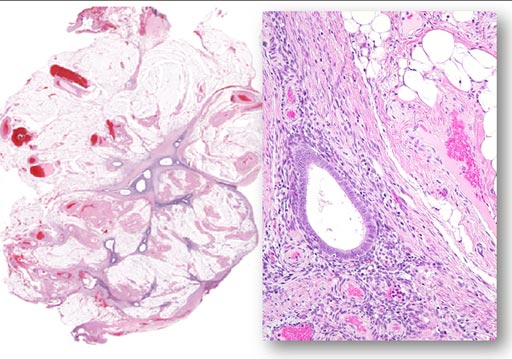Gene Sequencing Reveals Mutations in Endometriosis
|
By LabMedica International staff writers Posted on 24 May 2017 |

Image: Endometriosis in the peritoneal tissue (left) forming a scar. Under microscopy, it is composed of glands and surrounding stroma with chronic inflammation and fibrosis (Photo courtesy of Ie-Ming Shih).
Endometriosis occurs when tissue lining the uterus forms and grows outside of the organ, most often into the abdomen. The disease occurs in up to 10% of women before menopause and half of those with abdominal pain and infertility problems.
Endometriosis is defined as the presence of ectopic endometrial stroma and epithelium and can cause pelvic pain and infertility. Endometriotic lesions are considered to be benign inflammatory lesions but have cancer like features such as local invasion and resistance to apoptosis. Endometriosis most commonly involves the ovaries, fallopian tubes and the tissue lining of the pelvis. Rarely, endometrial tissue may spread beyond pelvic organs.
A large group of scientists led by those at Johns Hopkins Medicine analyzed deeply infiltrating endometriotic lesions from 27 patients by means of exomewide sequencing (24 patients) or cancer-driver targeted sequencing (three patients). Mutations were validated with the use of digital genomic methods in microdissected epithelium and stroma. Seven of the 24 women were from Japan; the rest were patients at Lenox Hill Hospital-Northwell Health. The use of samples from Japanese women was selected because endometriosis before menopause occurs more often in Asian women (13% to 18%) than in Caucasian women (6% to 10%).
The team found that of the 24 women, 19 had one or more mutations in their endometriosis tissue that were not present in their normal tissue. The type and number of mutations varied per endometriosis lesion and between each of the women. The most common mutations, occurring in five of the women, occurred in genes including ARID1A, PIK3CA, KRAS and PPP2R1A, all known for controlling cell growth, cell invasion and DNA damage repair. In an additional group of endometriosis samples biopsied from 15 women from British Columbia, the scientists looked specifically for mutations in the KRAS gene, whose expression signals proteins that spur cell growth and replication. They found KRAS mutations in five of the 15 patients.
Nickolas Papadopoulos, PhD, a professor of oncology and pathology and a co-author of the study, said, “We were surprised to find cancer-linked genes in these benign endometriosis samples because these lesions do not typically become cancer. We don't yet understand why these mutations occur in these tissues, but one possibility is that they could be giving the cells an advantage for growth and spread.” The study was published on May 11, 2017, in the New England Journal of Medicine.
Endometriosis is defined as the presence of ectopic endometrial stroma and epithelium and can cause pelvic pain and infertility. Endometriotic lesions are considered to be benign inflammatory lesions but have cancer like features such as local invasion and resistance to apoptosis. Endometriosis most commonly involves the ovaries, fallopian tubes and the tissue lining of the pelvis. Rarely, endometrial tissue may spread beyond pelvic organs.
A large group of scientists led by those at Johns Hopkins Medicine analyzed deeply infiltrating endometriotic lesions from 27 patients by means of exomewide sequencing (24 patients) or cancer-driver targeted sequencing (three patients). Mutations were validated with the use of digital genomic methods in microdissected epithelium and stroma. Seven of the 24 women were from Japan; the rest were patients at Lenox Hill Hospital-Northwell Health. The use of samples from Japanese women was selected because endometriosis before menopause occurs more often in Asian women (13% to 18%) than in Caucasian women (6% to 10%).
The team found that of the 24 women, 19 had one or more mutations in their endometriosis tissue that were not present in their normal tissue. The type and number of mutations varied per endometriosis lesion and between each of the women. The most common mutations, occurring in five of the women, occurred in genes including ARID1A, PIK3CA, KRAS and PPP2R1A, all known for controlling cell growth, cell invasion and DNA damage repair. In an additional group of endometriosis samples biopsied from 15 women from British Columbia, the scientists looked specifically for mutations in the KRAS gene, whose expression signals proteins that spur cell growth and replication. They found KRAS mutations in five of the 15 patients.
Nickolas Papadopoulos, PhD, a professor of oncology and pathology and a co-author of the study, said, “We were surprised to find cancer-linked genes in these benign endometriosis samples because these lesions do not typically become cancer. We don't yet understand why these mutations occur in these tissues, but one possibility is that they could be giving the cells an advantage for growth and spread.” The study was published on May 11, 2017, in the New England Journal of Medicine.
Latest Pathology News
- Blood Test and Sputum Analysis Predict Acute COPD Exacerbation
- AI Tool to Transform Skin Cancer Detection with Near-Perfect Accuracy
- Unique Immune Signatures Distinguish Rare Autoimmune Condition from Multiple Sclerosis
- Simple Optical Microscopy Method Reveals Hidden Structures in Remarkable Detail
- Hydrogel-Based Technology Isolates Extracellular Vesicles for Early Disease Diagnosis
- AI Tool Improves Accuracy of Skin Cancer Detection
- Highly Sensitive Imaging Technique Detects Myelin Damage
- 3D Genome Mapping Tool to Improve Diagnosis and Treatment of Genetic Diseases
- New Molecular Analysis Tool to Improve Disease Diagnosis
- Tears Offer Noninvasive Alternative for Diagnosing Neurodegenerative Diseases
- AI-Powered Method Combines Blood Data to Accurately Measure Biological Age
- AI Tool Detects Cancer in Blood Samples In 10 Minutes
- AI Pathology Analysis System Delivers Comprehensive Cancer Diagnosis
- AI Improves Cervical Cancer Screening in Low-Resource Settings
- New Multi-Omics Tool Illuminates Cancer Progression
- New Technique Detects Genetic Mutations in Brain Tumors During Surgery within 25 Minutes
Channels
Clinical Chemistry
view channel
Chemical Imaging Probe Could Track and Treat Prostate Cancer
Prostate cancer remains a leading cause of illness and death among men, with many patients eventually developing resistance to standard hormone-blocking therapies. These drugs often lose effectiveness... Read more
Mismatch Between Two Common Kidney Function Tests Indicates Serious Health Problems
Creatinine has long been the standard for measuring kidney filtration, while cystatin C — a protein produced by all human cells — has been recommended as a complementary marker because it is influenced... Read moreHematology
view channel
Platelet Activity Blood Test in Middle Age Could Identify Early Alzheimer’s Risk
Early detection of Alzheimer’s disease remains one of the biggest unmet needs in neurology, particularly because the biological changes underlying the disorder begin decades before memory symptoms appear.... Read more
Microvesicles Measurement Could Detect Vascular Injury in Sickle Cell Disease Patients
Assessing disease severity in sickle cell disease (SCD) remains challenging, especially when trying to predict hemolysis, vascular injury, and risk of complications such as vaso-occlusive crises.... Read more
ADLM’s New Coagulation Testing Guidance to Improve Care for Patients on Blood Thinners
Direct oral anticoagulants (DOACs) are one of the most common types of blood thinners. Patients take them to prevent a host of complications that could arise from blood clotting, including stroke, deep... Read moreImmunology
view channel
Chip Captures Cancer Cells from Blood to Help Select Right Breast Cancer Treatment
Ductal carcinoma in situ (DCIS) accounts for about a quarter of all breast cancer cases and generally carries a good prognosis. This non-invasive form of the disease may or may not become life-threatening.... Read more
Blood-Based Liquid Biopsy Model Analyzes Immunotherapy Effectiveness
Immunotherapy has revolutionized cancer care by harnessing the immune system to fight tumors, yet predicting who will benefit remains a major challenge. Many patients undergo costly and taxing treatment... Read moreMicrobiology
view channel
Rapid Assay Identifies Bloodstream Infection Pathogens Directly from Patient Samples
Bloodstream infections in sepsis progress quickly and demand rapid, precise diagnosis. Current blood-culture methods often take one to five days to identify the pathogen, leaving clinicians to treat blindly... Read more
Blood-Based Molecular Signatures to Enable Rapid EPTB Diagnosis
Extrapulmonary tuberculosis (EPTB) remains difficult to diagnose and treat because it spreads beyond the lungs and lacks easily accessible biomarkers. Despite TB infecting 10 million people yearly, the... Read more
15-Minute Blood Test Diagnoses Life-Threatening Infections in Children
Distinguishing minor childhood illnesses from potentially life-threatening infections such as sepsis or meningitis remains a major challenge in emergency care. Traditional tests can take hours, leaving... Read more
High-Throughput Enteric Panels Detect Multiple GI Bacterial Infections from Single Stool Swab Sample
Gastrointestinal (GI) infections are among the most common causes of illness worldwide, leading to over 1.7 million deaths annually and placing a heavy burden on healthcare systems. Conventional diagnostic... Read morePathology
view channel
Blood Test and Sputum Analysis Predict Acute COPD Exacerbation
Chronic obstructive pulmonary disease (COPD) remains a major contributor to global illness, largely driven by cigarette smoking and marked by irreversible lung damage. Acute exacerbations can accelerate... Read more
AI Tool to Transform Skin Cancer Detection with Near-Perfect Accuracy
Melanoma continues to be one of the most difficult skin cancers to diagnose because it often resembles harmless moles or benign lesions. Traditional AI tools depend heavily on dermoscopic images alone,... Read more
Unique Immune Signatures Distinguish Rare Autoimmune Condition from Multiple Sclerosis
Myelin oligodendrocyte glycoprotein antibody–associated disease (MOGAD) is a rare autoimmune disorder in which the immune system attacks the myelin sheath in the central nervous system. Although symptoms... Read moreTechnology
view channel
AI Saliva Sensor Enables Early Detection of Head and Neck Cancer
Early detection of head and neck cancer remains difficult because the disease produces few or no symptoms in its earliest stages, and lesions often lie deep within the head or neck, where biopsy or endoscopy... Read more
AI-Powered Biosensor Technology to Enable Breath Test for Lung Cancer Detection
Detecting lung cancer early remains one of the biggest challenges in oncology, largely because current tools are invasive, expensive, or unable to identify the disease in its earliest phases.... Read moreIndustry
view channel
Abbott Acquires Cancer-Screening Company Exact Sciences
Abbott (Abbott Park, IL, USA) has entered into a definitive agreement to acquire Exact Sciences (Madison, WI, USA), enabling it to enter and lead in fast-growing cancer diagnostics segments.... Read more






















